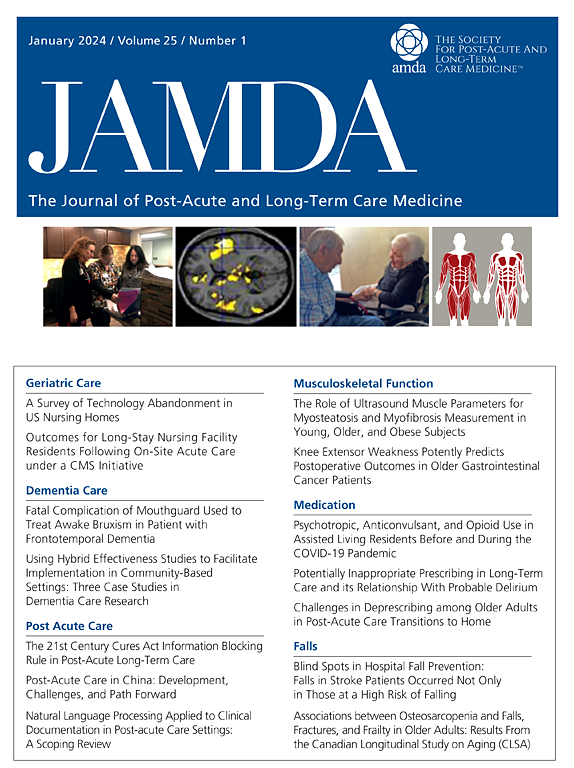The Association between Frailty, Quality of Life and Resilience in Community-dwelling Retirement Village Residents
IF 4.2
2区 医学
Q2 GERIATRICS & GERONTOLOGY
Journal of the American Medical Directors Association
Pub Date : 2024-09-11
DOI:10.1016/j.jamda.2024.105256
引用次数: 0
Abstract
Objectives
Housing quality has significant impact on the wider determinants of health and quality of life (QoL). Retirement villages are considered age-friendly accommodation for community-dwelling older people, offering a variable range of services and supports. We wished to explore the relationship among frailty, QoL, and resilience in older people residing in retirement villages.
Design
Cross-sectional analysis within a longitudinal study.
Setting and participants
Residents from 33 retirement villages in Auckland, Aotearoa, New Zealand.
Methods
Frailty [using an interRAI-Community Health Assessment-based frailty index FI)], QoL [World Health Organization Quality of Life–Brief Version (WHOQOL-BREF) and WHOQOL–Older Adults Module (WHOQOL-OLD)], and resilience [Brief Resilience Scale (BRS)]. Associations among frailty, QoL, and resilience were examined using regression analysis adjusting for confounders.
Results
Mean (SD): FI 0.2 (0.1) in 479 residents, BRS 3.7 (0.8) in 395 residents, WHOQOL-OLD total score 69.9 (12.2). FI was inversely related to BRS [adjusted mean difference (MD) −0.35; 95% CI −0.43 to −0.26; P < .001] and WHOQOL-OLD (MD, −5.45; 95% CI −6.89 to 4.01; P < .001). FI inverse relationship was seen across all facets of WHOQOL-OLD and all WHOQOL-BREF facets except psychological.
Conclusions and Implications
Frailty was inversely related to resilience and multiple domains of QoL in those living in presumed age-friendly and relatively resource-rich environments. Studies exploring causal relationships between these facets could inform interventions necessary to improve QoL and resilience in those living with frailty. Specific multidimensional needs, wishes, and concerns of older people living with frailty needs to be explored in order to potentially intervene on frailty, QoL, and resilience.
社区退休村居民的虚弱程度、生活质量和复原力之间的关系。
目标:住房质量对更广泛的健康和生活质量(QoL)决定因素具有重大影响。退休村被认为是适合社区老年人居住的老年友好型住所,可提供各种服务和支持。我们希望探讨居住在退休村的老年人的虚弱程度、生活质量和恢复力之间的关系:设计:纵向研究中的横断面分析:环境和参与者:新西兰奥克兰市 33 个退休村的居民:虚弱程度(使用基于虚弱指数[FI]的interRAI-Community Health Assessment)、QoL(世界卫生组织生活质量简明版[WHOQOL-BREF]和WHOQOL-Older Adults模块[WHOQOL-OLD])和复原力(简明复原力量表[BRS])。在对混杂因素进行调整后,采用回归分析法对虚弱、QoL 和复原力之间的关系进行了研究:平均值(标清)479名居民的FI为0.2(0.1),395名居民的BRS为3.7(0.8),WHOQOL-OLD总分为69.9(12.2)。FI与BRS(调整后平均差 [MD] -0.35;95% CI -0.43至-0.26;P < .001)和WHOQOL-OLD(MD,-5.45;95% CI -6.89至4.01;P < .001)呈反向关系。FI与WHOQOL-OLD的所有方面和WHOQOL-BREF的所有方面(心理除外)均呈反向关系:对于那些生活在假定对老年人友好且资源相对丰富的环境中的人来说,虚弱与复原力和 QoL 的多个方面成反比关系。对这些方面之间因果关系的研究可以为改善体弱者的 QoL 和恢复力所需的干预措施提供信息。需要对体弱老年人的特定多维需求、愿望和关注点进行探索,以便有可能对体弱、质量生活和恢复能力进行干预。
本文章由计算机程序翻译,如有差异,请以英文原文为准。
求助全文
约1分钟内获得全文
求助全文
来源期刊
CiteScore
11.10
自引率
6.60%
发文量
472
审稿时长
44 days
期刊介绍:
JAMDA, the official journal of AMDA - The Society for Post-Acute and Long-Term Care Medicine, is a leading peer-reviewed publication that offers practical information and research geared towards healthcare professionals in the post-acute and long-term care fields. It is also a valuable resource for policy-makers, organizational leaders, educators, and advocates.
The journal provides essential information for various healthcare professionals such as medical directors, attending physicians, nurses, consultant pharmacists, geriatric psychiatrists, nurse practitioners, physician assistants, physical and occupational therapists, social workers, and others involved in providing, overseeing, and promoting quality

 求助内容:
求助内容: 应助结果提醒方式:
应助结果提醒方式:


